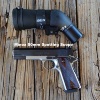greyling22
Member
I don't really know how to ask this question, but I'm going to try and muddle through it.
I always heard that as scope magnification got higher, the quality of glass mattered more. for example, a $200 3-9x is a nice clear scope, but take that same quality of glass, crank the power up to 18 or 20x, and you end up with a dark and murky image. And that if you have a 5-20x scope, the 5x might be nice and clear, but as you get up into the upper range you lose image quality.
These days, I'm seeing a lot of high magnification 5-25x scopes in the $300-700 range. Does that still hold true? For example, meopta offers their optika 5 line in 2-10, 3-15x , and 4-20x. Assuming the glass quality is the same in all of them, If I set them all on 10x, should I expect the same quality of image? or do you run into issues at the top end of the magnification range? If I really didn't think I needed 20x, but somewhere in the 8-12x power, would I get a better picture with the 4-20 than the 3-15 since I wouldn't be in the upper range of the magnification?
I guess that I'm trying to ask, if I really wanted a nice 15x scope, and the same model line offered a 15x and a 25x, would 15x look a lot nicer on the 25 than on the 15, because I wasn't pushing the scope to it's optical limits?
I always heard that as scope magnification got higher, the quality of glass mattered more. for example, a $200 3-9x is a nice clear scope, but take that same quality of glass, crank the power up to 18 or 20x, and you end up with a dark and murky image. And that if you have a 5-20x scope, the 5x might be nice and clear, but as you get up into the upper range you lose image quality.
These days, I'm seeing a lot of high magnification 5-25x scopes in the $300-700 range. Does that still hold true? For example, meopta offers their optika 5 line in 2-10, 3-15x , and 4-20x. Assuming the glass quality is the same in all of them, If I set them all on 10x, should I expect the same quality of image? or do you run into issues at the top end of the magnification range? If I really didn't think I needed 20x, but somewhere in the 8-12x power, would I get a better picture with the 4-20 than the 3-15 since I wouldn't be in the upper range of the magnification?
I guess that I'm trying to ask, if I really wanted a nice 15x scope, and the same model line offered a 15x and a 25x, would 15x look a lot nicer on the 25 than on the 15, because I wasn't pushing the scope to it's optical limits?









